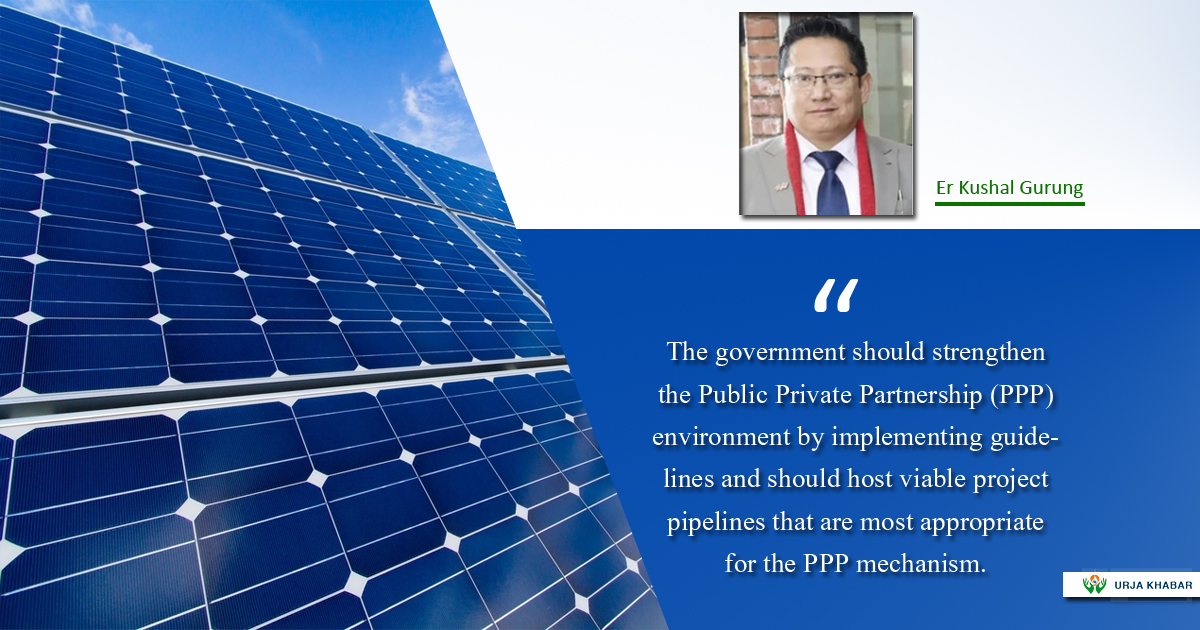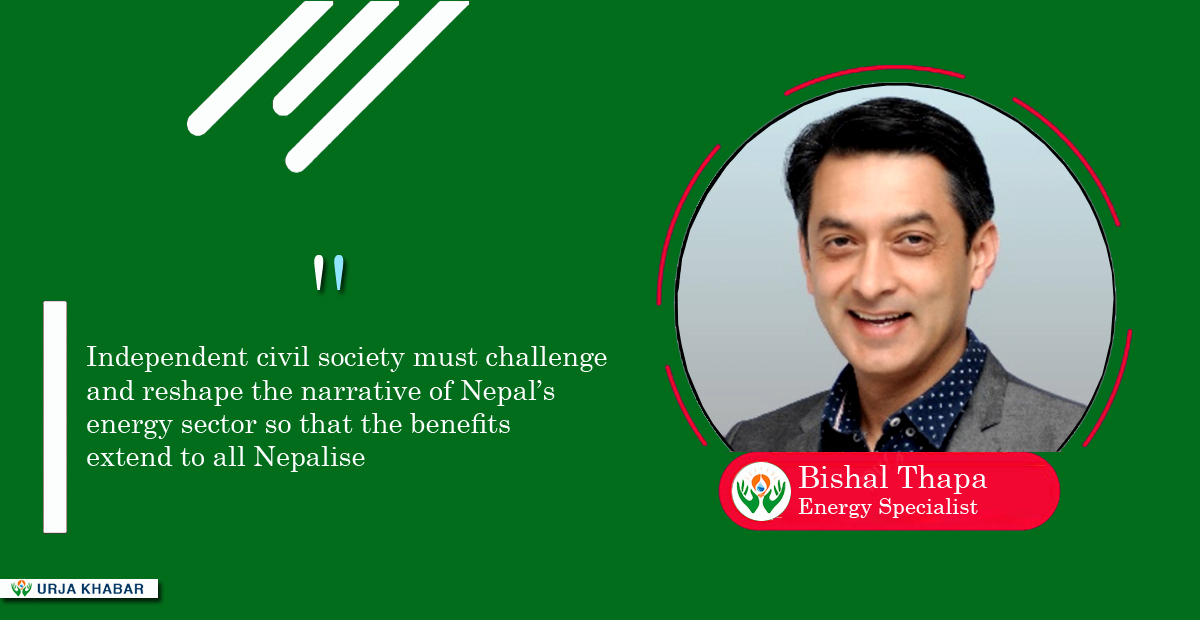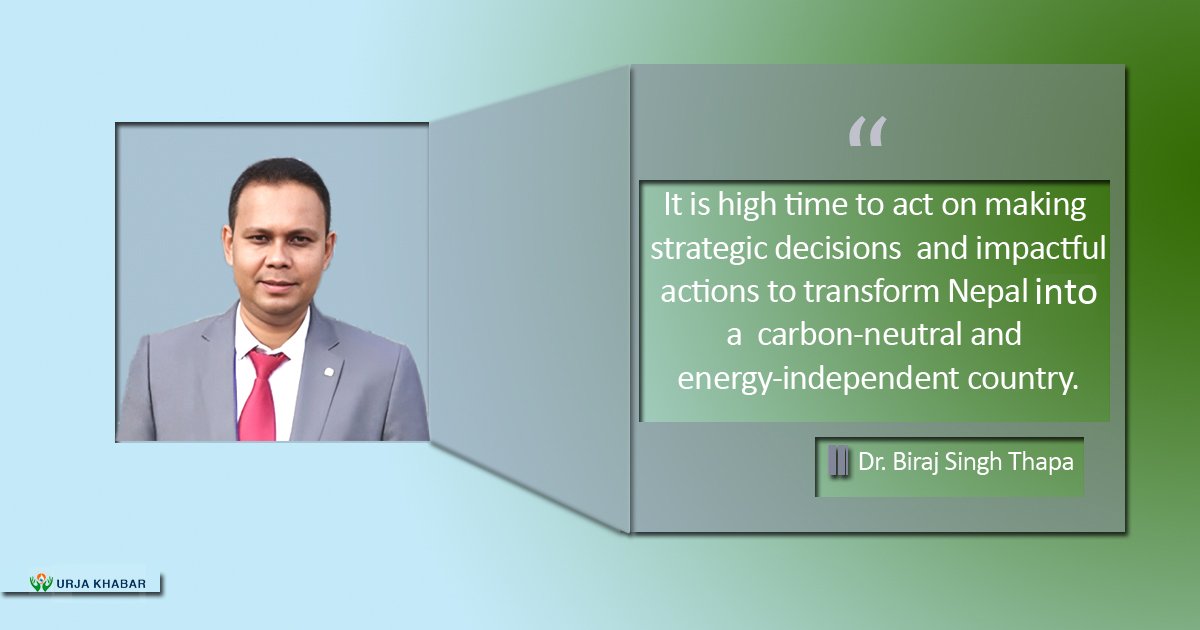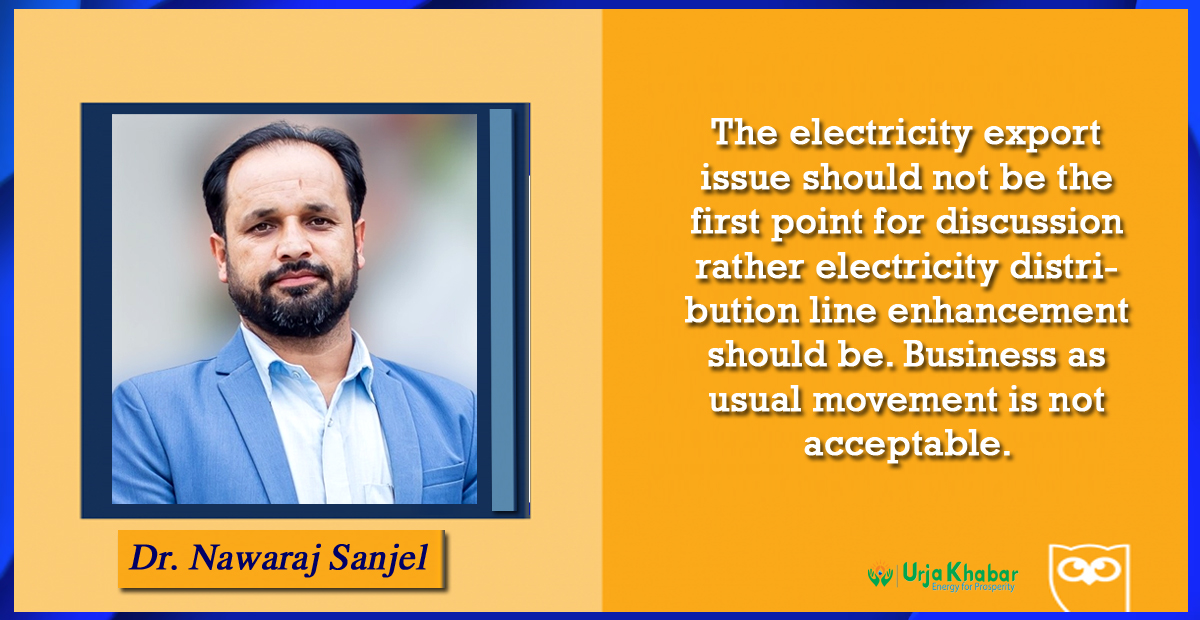Energy Update
Mixing solar-generated electricity in the grid to meet energy target

Kathmandu; Energy mix of Nepal, albeit hydropower having a mammoth share, could become more diverse in the forthcoming years with pragmatic government policies and developers’ zeal on renewable energy projects.
In the second Nationally Determined Contribution (NDC) that Nepal submitted to UNFCCC in December 2020, the country has pledged to generate 15,000 MW of electricity by 2030. Out of the total amount, 5-10 percent will be from renewable energy sources. And as Nepal has huge potential also for solar energy generation, it can definitely help the nation accomplish its commitment. Nepal receives optimal sunshine of around 300 days throughout a year, with an average solar irradiance varying from 3.6 – 6.2 kWh/m2/day. The figure is almost double compared to Germany where more than 59,000 MW of solar Photovoltaic (PV) have been installed, which supply almost nine percent of its total electricity generation of the country.

Nepal Electricity Authority (NEA), the state-owned utility, started accepting on-grid solar power purchase agreement (PPA) only after the introduction of guideline for “Development of Alternative Energy Connected to Grid” in 2018. The new rule has allowed producers to connect up to 10 percent of electricity generated from alternative energy sources like solar, wind and bioenergy to the national grid, at a flat rate of Rs 7.30 per kWh for 20 years. In the short time span following the guideline came online, already nine SPV projects totaling around 44 MW have been connected to the grid, while many others are in the pipeline. So far, 30 solar projects totaling 1,059 MW have acquired survey licenses, out of which 118 MW are currently under construction. However, the boosted momentum in installation of solar projects has hit a snag recently after the government decided to slash the solar PPA rate to Rs 5.94 per unit as a maximum base rate, with a provision for open competitive bidding.
Despite having a good potential, there are few challenges for the implementation of utility-scale solar PV project in Nepal. In general, a solar farm needs around 25 ropanis of land per MW. The prevailing act and policy makes it difficult to pool large areas of land needed for building big solar projects to take advantage of 'economy of scale'. The land acquisition process is more difficult for projects that lie within protected areas. And ironically, one of the most potential sites for solar projects, with an average daily photovoltaic power potential of 5.4 kWh/kWp is Mustang district, which lies inside the Annapurna Conservation Area. The government also prohibits using cultivable irrigated land for solar PV projects, which impedes the concept of Agrivoltaic- a system that integrates crop production and PV power generation.

Likewise, the processes of legal approvals and clearances are quite cumbersome due to lack of implementation of one door systems in the segment. Receiving approvals related to environmental issues could take several years; and in case if the information provided in Environmental Impact Assessment (EIA) report deviates more than 10 percent with the field information, the project developer would have to conduct supplementary EIA, thus incurring additional cost and time. Right of way for transmission lines is another major issue. Furthermore, if independent power producers (IPPs) have to develop their own transmission lines, then it also makes the project commercially less feasible. Inadequacy in grid infrastructure and unstable grids also discourage project developers from investing in solar projects. On top of all these, the threshold for purchasing power not exceeding 10 percent of installed grid capacity, provides very little opportunity for solar projects to flourish. The low target of 15,000 MW installed capacity means, Nepal cannot exceed more than 1500 MW of on-grid solar PV installation by 2030. And at the current pace of hydro projects development, with only around 2100 MW of installed grid capacity till date, it is almost impossible to add another 13,000 MW in the next eight years, thus further confining the opportunity for on-grid solar PV projects.
Nepal’s need for transition to its energy mix
It is imperative to diversify the power generation mix into the grid in order to achieve sustainable development. The current progress rate of hydropower development might not be sufficient to meet the future energy demand of the country as most of the hydropower project in Nepal are run-off-river type with design discharge of Q40%, which means that they are only capable of delivering around 40 percent of their full capacity during dry months, thus creating extensive power shortage during rest of the period of the year. On the other hand, effect of climate change has been causing high-intensity rainfall almost every year, resulting in an increased water-induced disasters like flooding, flash floods, landslides, debris flows, slop failures and even Glacier Lake Outburst Floods (GLOFs), wreaking havoc to downstream hydropower projects.
According to the Independent Power Producers’ Association, Nepal (IPPAN), in 2021 alone, the monsoon-induced hazards wrecked many hydropower projects, causing losses of around Rs 10 billion. The 44 MW Super Madi Hydropower Project was the most affected infrastructure with losses of more than Rs 1 billion. Similarly, the earthquake of 2015 and massive flooding of 2017 have also elucidated that hydropower plants of the country are prone to such natural disasters.
We can offset these types of risks to hydropower by building more solar PV projects, as they are less affected by water-related disasters and are less time and cost consuming to get repaired and rebuilt. Furthermore, solar and hydropower complement each other. While solar plants can generate more electricity during dry seasons, hydropower plants are more productive during the rainy season.
Besides, the construction period for hydropower is lengthy, which could take around three to five years on average, while a utility-scale solar plant could be commissioned within six months. As an example, the 10 MW Mithila Saurya solar PV plant in Dhalkebar of Dhanusha district, was completed in just six months despite the crisis and challenges faced due to COVID-19 pandemic. Juxtaposing the project cost, the CAPEX for per MW of electricity production from solar energy is almost half to that of hydro energy and this could continue to plummet further as the cost of solar panels, which accounts for 50-60 percent of the total project cost, is in declining trend. In Nepal, the cost per MW of grid-connected PV systems currently ranges from 80 to 100 million rupees, whereas for hydropower it ranges from 200 million to 250 million. In order to meet our target of 15,000 MW of electricity and to increase energy security, the government should increase the current provision of 5-10 percent renewable energy cap to at least 20 percent.
Solar energy in Nepal – 2022 and beyond
Feasible solutions should be explored and identified to boost solar energy in Nepal’s energy mix. PV modules can be extremely sensitive to mechanical pressure. Therefore, safe logistics practices such as access road networks, using hydraulic trucks and detailed pre-planning, whichever is deemed effective, should be adopted. Similarly, the government should categorize land use based on the resources available and cost benefit analysis, which would give an idea on whether the land can be used for project development or not. For the convenience of project developers and promotion of hassle-free project completion, a checklist should be prepared, which should clearly mention the details on licensing process, authorities involved and the permits required from the authorities concerned, clear land acquisition process for private and government land along with the required materials and templates. Standard guidelines should be prepared for Agrivoltaics to promote agriculture inside solar farms. The government should strengthen the Public Private Partnership (PPP) environment by implementing guidelines and should host viable project pipelines that are most appropriate for the PPP mechanism.
To achieve our energy goals, the implementation of suitable business models that have been practiced around the world can be another way. Solar Energy Corporation of India (SECI) may be one of the best models to replicate in Nepal. It is a central Public Sector Undertaking dedicated to the solar energy sector in India and has the role of auctioning and managing solar power plants. Initially, SECI develops large-scale projects and later auctions them to IPPs to build, own and operate. It signs 25-years PPAs with developers who directly sell the power to SECI. SECI then sells the power to state electricity-distributing companies at a nominal premium. It also provides Payment Guarantee Scheme (PGS) which has the provision of providing guarantee in case of a discoms default, resulting in boosting the confidence of developers. Adopting this model could be a win-win situation for both IPPs and Utilities, as the IPPs do not have to spend time and resources developing the project, while due to the bidding process, the utilities get electricity at a competitive rate. In addition, development of infrastructure for the electricity project such as transmission lines, access roads, provision of PGS and PPA for a longer time period, will attract more project developers; increasing the share of solar power at national grid.
In essence, with growing market opportunities and numerous benefits, namely: economic benefits, energy security, portfolio diversification, social equity and environmental protection, a transition is must to promote and scale up on-grid solar PV projects in Nepal. And all Nepal needs is, better policies and serious commitments to harness its abundant solar energy resources, and consequently help the country meet its energy targets and achieve desired economic growth.
The Writer is an Energy Specialist; We have taken this article from Urja Khabar Biannual Journal Publish on 22nd June, 2022
Conversation
- Info. Dept. Reg. No. : 254/073/74
- Telephone : +977-1-5321303
- Email : [email protected]














